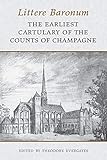Littere Baronum : The Earliest Cartulary of the Counts of Champagne / ed. by Theodore Evergates.
Material type: TextSeries: Medieval Academy BooksPublisher: Toronto : University of Toronto Press, [2003]Copyright date: ©2003Description: 1 online resource (230 p.)Content type:
TextSeries: Medieval Academy BooksPublisher: Toronto : University of Toronto Press, [2003]Copyright date: ©2003Description: 1 online resource (230 p.)Content type: - 9781442657656
- 9781442620865
- 944/.3021
- DC611.C446
- online - DeGruyter
| Item type | Current library | Call number | URL | Status | Notes | Barcode | |
|---|---|---|---|---|---|---|---|
 eBook
eBook
|
Biblioteca "Angelicum" Pont. Univ. S.Tommaso d'Aquino Nuvola online | online - DeGruyter (Browse shelf(Opens below)) | Online access | Not for loan (Accesso limitato) | Accesso per gli utenti autorizzati / Access for authorized users | (dgr)9781442620865 |
restricted access online access with authorization star
http://purl.org/coar/access_right/c_16ec
The cartulary of 1211 is the oldest surviving register produced by the chancery of the counts of Champagne. This first edition of the cartulary contains 121 letters received from the barons and prelates of the county during the rule of Count Thibaut III (1198-1201) and the first decade of the regency of his widow, Countess Blanche (1201-22).They deal primarily with feudal matters--homage, tenure, the construction and rendering of castles--and lordship over property and rural communities. Since only one-third of the original letters survive, the cartulary copies are particularly valuable in capturing the range of written records entering the chancery of a major French principality around 1200.The introduction to the volume traces the evolution of aristocratic letters patent from the 1140s and argues that they were far more important in the twelfth century, both for transactions between laymen and for transactions with religious houses, than historians of medieval diplomacy have allowed. The introduction goes on to discuss the evolution of the chancery in the twelfth century, the creation of a formal chancery archive in the 1190s, and the organization and contents of the cartulary complied in 1211.
Mode of access: Internet via World Wide Web.
In English.
Description based on online resource; title from PDF title page (publisher's Web site, viewed 01. Nov 2023)


